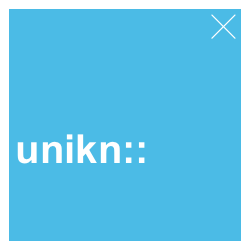
The unikn package provides useful color functions — by defining dedicated colors and color palettes, and commands for changing, viewing, and using them — and styled text elements (e.g., for marking, underlining, or plotting colored titles) in R. The package’s pre-defined range of colors and text functions is based on the corporate design of the University of Konstanz (see this link for details), but can easily be adapted and extended to other purposes or institutions.
Institutions devise corporate design (CD) manuals for creating and
maintaining a consistent impression in presentations and publications.
In 2014, the University of
Konstanz introduced a highly recognizable corporate design. Its key
component is the ubiquitous use of a Seeblau color and a
corresponding color palette that blends various shades of
Seeblau (in boxes, lines, and other graphical elements)
with text (in black-and-white). (See the corporate
design pages for details.)
The unikn package facilitates the use of corporate design elements for users of R. While this renders the use of default specifications simple and straightforward, experienced users can apply the color tools in a flexible and creative fashion (e.g., for designing color palettes to be used in scientific visualizations).
The unikn package currently provides five types of objects and functions:
Some dedicated colors and color
palettes (e.g., Seeblau and
pal_unikn);
Functions for viewing and comparing colors
(seecol()), and for using or changing color
palettes (usecol());
Functions for creating color palettes
(newpal()), for finding similar colors
(simcol()), and for searching color names
(grepal());
Functions for plotting graphical objects (e.g., boxes and frames);
Functions for plotting styled text elements
(e.g., highlighting and underlining text).
Essentially, unikn began by defining some colors, but has now grown into a toolbox for addressing color- and plotting-related tasks in R. As we have fun creating it, we hope you find the package useful too — and please use responsibly!
The latest release of unikn is available from CRAN at https://CRAN.R-project.org/package=unikn:
install.packages('unikn') # install from CRAN client
library('unikn') # loads the packageThe current development version can be installed from its GitHub repository at https://github.com/hneth/unikn/:
# install.packages('devtools') # (if not installed yet)
devtools::install_github('hneth/unikn')
library('unikn') # loads the packageA distinctive and recognizable color scheme is the most recognizable element of the University of Konstanz’s corporate design.
Basic color palettes are defined according to the Corporate Design Manual (see the corporate design specifications).
The default color palette pal_unikn combines:
pal_seeblau (reversed, i.e., from darker to
lighter);"white" (as the center color);pal_grau[1:4]);"black" (as the last color).This yields a diverging, symmetrical default color palette
pal_unikn consisting of 11 colors:
# Default color palette: -----
# pal_unikn # 11 default colors
# View color palette (by plotting it): -----
seecol(pal_unikn)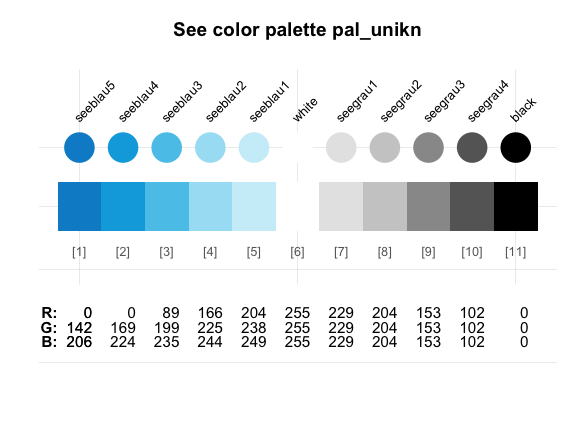
A shorter version consisting of 10 colors is provided
as pal_unikn_web.
An alternative color palette with 10 more muted colors (intended
for PowerPoint presentations) is provided
as pal_unikn_ppt.
Evaluating seecol(pal = "unikn_basic") shows these three
basic unikn color palettes.
Beyond the three variants of pal_unikn, the
unikn package provides the following color
palettes:
seecol("all")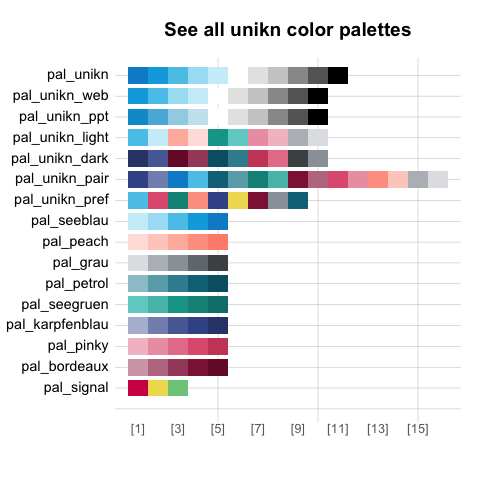
The color palettes pal_unikn_web() and
pal_unikn_ppt() correspond to the official definitions of
color palettes for electronic and print media, respectively. The default
palette pal_unikn of unikn combines the
five shades of blue in pal_seeblau with the six non-blue
colors from pal_unikn_web() to create a symmetrical palette
of 11 colors.
All color palettes exported by unikn are built from elements consisting of nine different color hues. Specifically, an Excel file entitled Colours for complex graphics defines 9 color gradients that are created and exported by unikn as the following named color palettes:
seecol(pal = "grad_all")Overall, the unikn package exports 16 dedicated
color palettes, plus the nine preferred colors of
pal_unikn_pref (e.g., Seeblau,
Seegruen, etc.) as named colors. For details on each named
color hue, evaluate seecol() on the following color
palettes:
# 8 mono-tone palettes: -----
# Name: Nr: Tone:
pal_seeblau # 5 shades of seeblau
pal_peach # 5 peach
pal_grau # 5 grau
pal_petrol # 5 petrol
pal_seegruen # 5 seegruen
pal_karpfenblau # 5 karpfenblau
pal_pinky # 5 pink
pal_bordeaux # 5 Bordeaux
# 1 signal (Ampel) palette: -----
pal_signal # 3 signal/AmpelEach color palette contains a preferred color.[1] All preferred
colors (i.e., named colors of distinct color hues) are contained in a
corresponding color palette pal_unikn_pref:
# See the palette of 9 preferred colors/hues:
seecol(pal_unikn_pref)
# Using preferred colors:
pal_unikn_pref # color palette of 9 preferred colors
pal_unikn_pref[1] # preferred (named) color 1
pal_unikn_pref[[1]] # color value 1: #59C7EB"
pal_unikn_pref["Seeblau"] # preferred color by nameAdditional pre-defined color palettes in unikn include:
# See additional color palettes:
seecol(pal_unikn_light) # palette of 8 light colors (in 4 pairs)
seecol(pal_unikn_dark) # palette of 8 dark colors (in 4 pairs)
seecol(pal_unikn_pair) # palette of 16 paired colors (in 8 pairs)More flexible and complex color palettes can be created by using the
seecol() and usecol() functions.
Two main functions — seecol() and
usecol() — provide a simple interface for viewing
and using color palettes.
Additional color functions (i.e., newpal(),
grepal(), shades_of(), and ac())
provide auxiliary functionality (like creating new color palettes,
finding colors whose names match some pattern, creating color gradients,
or adding transparency to colors).
seecol()The seecol() function enables a quick inspection of a
color palette. It provides a quick overview over the details of a color
palette and allows comparisons between multiple color palettes:
# Plot a color palette:
seecol(pal = pal_unikn_pref, # palette to plot
col_brd = "white", lwd_brd = 5) # color and width of borders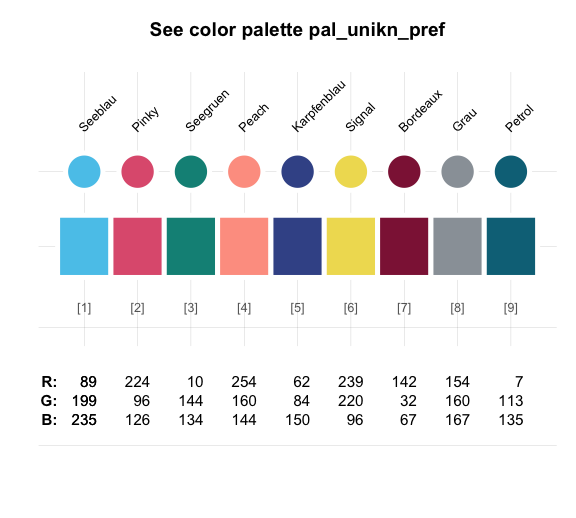
When only a subset of a color palette are needed, the
seecol() and usecol() functions provide a
reasonable subset of a known unikn color palette:
# Subset of all color palettes:
seecol(n = 4)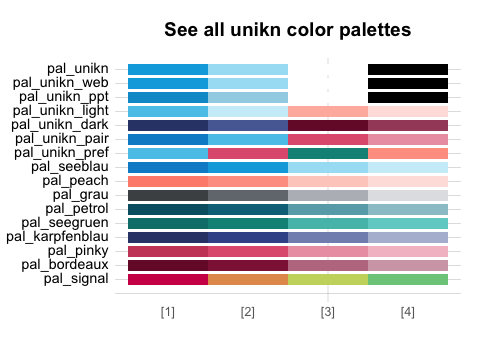
# Details of a partial palette:
# seecol(pal_seeblau, n = 4)The usecol() and seecol() functions provide
some generic options for manipulating and showing color gradients based
on given colors or color palettes. This serves two main functions:
Here are some examples of both functions in action:
seecol(pal_unikn, n = 21) # extend a color palette
Users of the %>% operator (from the
magrittr package) may prefer the following pipe:
library(magrittr)
usecol(pal_unikn, n = 21) %>% seecol()Note that reducing an unikn color palette selects a suitable subset of its colors, rather than just truncating the scale.
seecol(c(rev(pal_petrol), "white", pal_bordeaux), 11, col_bg = "grey90")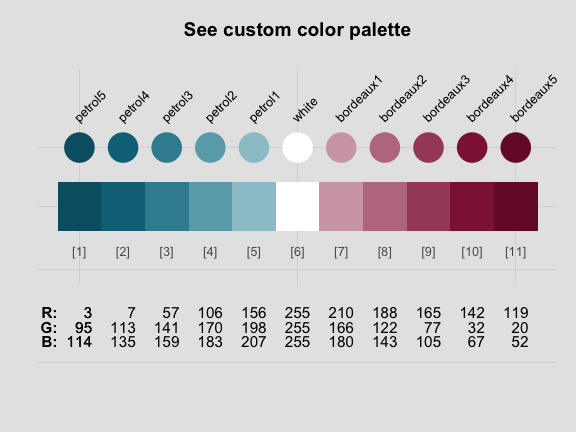
Related examples include:
seecol(c(rev(pal_seeblau), "white", pal_pinky), 11)
seecol(c(rev(pal_seeblau), "white", pal_seegruen), 11)
seecol(c(rev(pal_seeblau), "white", pal_peach), 11)usecol()The usecol() function provides convenient access and
additional options for using them in graphs. Here are some examples:
By default, simply set the color argument of a plot to
usecol() with some unikn color
palette:
# (a) Using a color palette:
barplot(1/sqrt(1:11), col = usecol(pal_unikn))
Two additional arguments allow modifying the existing color palette:
providing a value for n reduces or extends the
selected color palette;
adding an opacity value for alpha (in the range
[0, 1]) regulates color transparency.
image() from graphics):# Random images:
set.seed(1)
n <- 20
m <- matrix(rnorm(n*n), ncol = n, nrow = n)
# image(m, col = seecol(pal_seeblau)) # seecol() shows & use colors
# image(m, col = usecol(pal_peach)) # usecol() only uses colors
# image(m, col = usecol(pal_seegruen))
# image(m, col = usecol(pal_petrol))
image(m, col = usecol(pal_seeblau, n = 50),
main = "50 shades of Seeblau", axes = FALSE)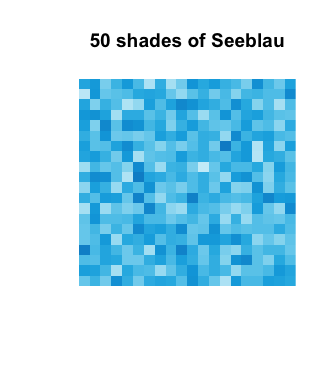
ggplot() commands
(using ggplot2):# 0. Create data: ----
# Example based on https://www.r-graph-gallery.com/137-spring-shapes-data-art/
n <- 50
names <- paste("G_", seq(1, n), sep = "")
df <- data.frame()
set.seed(3)
for(i in seq(1:30)){
data = data.frame(matrix(0, n, 3))
data[, 1] <- i
data[, 2] <- sample(names, nrow(data))
data[, 3] <- prop.table(sample( c(rep(0, 100), c(1:n)), nrow(data)))
df = rbind(df, data)}
colnames(df) <- c("X","group","Y")
df <- df[order(df$X, df$group) , ]
# 1. Choose colors: ----
# (a) using RColorBrewer:
library(RColorBrewer)
cur_col <- brewer.pal(11, "Paired")
cur_col <- colorRampPalette(cur_col)(n)
cur_col <- cur_col[sample(c(1:length(cur_col)), size = length(cur_col))] # randomize
# (b) using unikn:
library(unikn)
cur_col <- usecol(pal = pal_unikn, n = n)
# cur_col <- cur_col[sample(c(1:length(cur_col)), size = length(cur_col))] # randomize
# 2. Plotting: ----
library(ggplot2)
ggplot(df, aes(x = X, y = Y, fill = group)) +
geom_area(alpha = 1, color = Grau, size = .01 ) +
theme_bw() +
scale_fill_manual(values = cur_col) +
theme_void() +
theme(legend.position = "none")
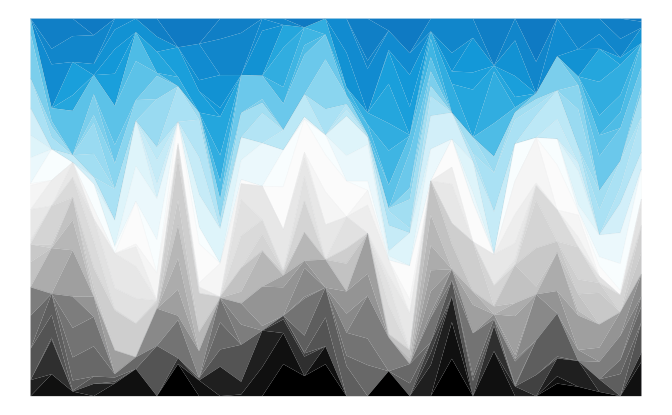
newpal()The newpal() function allows creating new color palettes
(typically as data frames with dedicated color names).
The color palettes included in the unikn package are based on the CD manual of the University of Konstanz, Germany. However, the functionality provided by the package makes it easy and straightforward to define and use your own color scales. In the following, we provide examples to illustrate how this can be achieved for other corporations or institutions.

The color scheme of Princeton University is easily recognized by its combination of orange with black and white elements. The official guidelines (available here) define “Princeton Orange” as Pantone (PMS) 158 C.
The PANTONE™ color finder at https://www.pantone.com/connect/158-C yields the following color values:
232 119 34#E877220 62 95 0However, the guide also specifies and distinguishes between two additional versions of orange and provides the following HEX/HTML values for them:
These definitions suggest defining three separate versions of orange and corresponding color palettes:
# HEX values for 3 shades of orange:
orange_basic <- "#E87722" # Pantone 158 C
orange_white <- "#E77500" # orange on white
orange_black <- "#F58025" # orange on black
# Defining color palettes:
pal_princeton <- c(orange_basic, "black")
names(pal_princeton) <- c("orange", "black")
pal_princeton_1 <- c(orange_white, "white", "black")
names(pal_princeton_1) <- c("orange_w", "white", "black")
pal_princeton_2 <- c(pal = c(orange_black, "black", "white"))
names(pal_princeton_2) <- c("orange_b", "black", "white")Alternatively, we can define both (colors and names) in 1 step by
using the newpal() function:
pal_princeton_1 <- newpal(col = c("#E77500", "white", "black"),
names = c("orange_w", "white", "black")
)
# seecol(pal_princeton_1)The new color palettes (e.g., pal_princeton_1) can now
be viewed with seecol(), scaled by usecol(),
and used in graphs (e.g., in ggplot commands):
# View color palette:
# seecol(pal_princeton_1)
# Scale color palette (using df and n from above):
my_pal <- usecol(pal = pal_princeton_1, n = n)
# Use my_pal for plotting:
ggplot(df, aes(x = X, y = Y, fill = group)) +
geom_area(alpha = 1, color = Grau, size = .01 ) +
theme_bw() +
scale_fill_manual(values = my_pal) +
theme_void() +
theme(legend.position = "none")
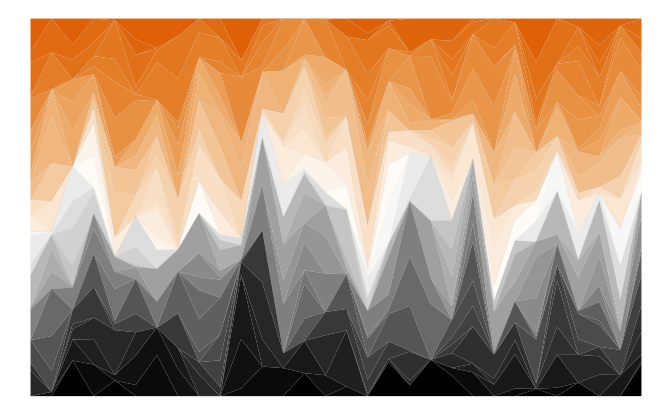
Color palettes for other entities and purposes can easily be created. To illustrate the steps involved, let’s create a color palette of the well-known Google logo.
The typical steps of creating a new palette are:
Choose some colors (and their R color names, or as RGB/HEX/HCL values, e.g., from sites like https://www.schemecolor.com).
Define the colors as an R vector (of type character).
Define their names as a second R vector (of type character).
Use the newpal() command to define the new color
palette.
Use the seepal() command to inspect the new color
palette.
# 1. Choose colors:
# Google logo colors (from <https://www.schemecolor.com/google-logo-colors.php>)
# 2. Define colors (as vector):
color_google <- c("#4285f4", "#34a853", "#fbbc05", "#ea4335")
# 3. Define color names (as vector):
names_google <- c("blueberry", "sea green", "selective yellow", "cinnabar")
# 4. Define color palette:
pal_google <- newpal(color_google, names_google)
# 5. Inspect color palette:
seecol(pal_google,
col_brd = "white", lwd_brd = 8,
title = "Colors of the Google logo")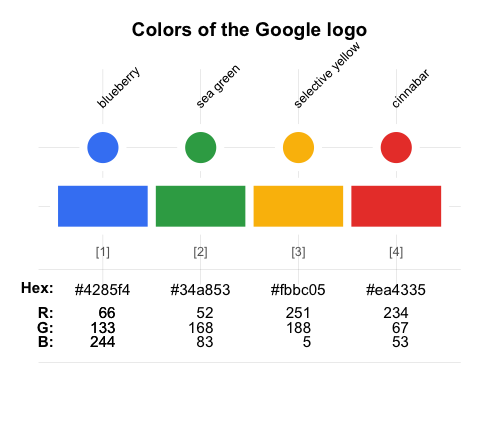
The new palette pal_google can now be used in R graphics
and modified in various ways (e.g., by the usecol()
function).
See the vignette on “Institutional colors” of the unikn package for additional examples.
grepal()The grepal() function allows finding colors in a color
palettes by matching their name to a pattern.
Specifically, grepal(pattern, x) searches a color
palette x (i.e., a vector of color names or data frame of
named colors) for elements that match a pattern and returns
those elements (colors) that match the pattern. The pattern
can be a regular expression.
By default, grepal() searches the 657 named colors
provided by colors() in base R:
# Find colors matching a pattern:
oranges <- grepal("orange", plot = FALSE)
# See color palette:
seecol(oranges,
col_brd = "white", lwd_brd = 2,
title = "Shades of 'orange' in colors()")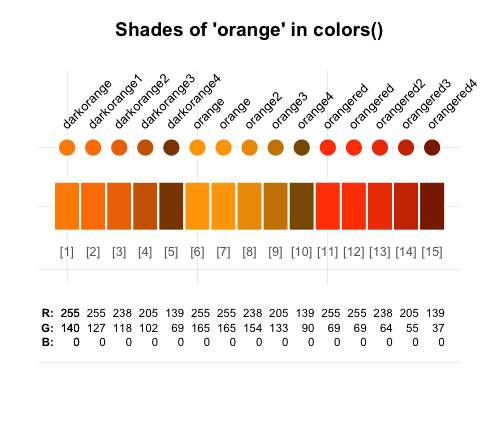
Providing a list of color palettes to the pal argument
of the seecol() function allows comparing multiple color
palettes:
# Find colors:
pink_olive <- grepal("(pink)|(olive)", plot = FALSE)
purple_orange <- grepal("(purple)|(orange)", plot = FALSE)
# See color palettes:
seecol(pal = list(pink_olive, purple_orange),
pal_names = c("pink|olive", "purple|orange"),
title = "Comparing pink olives and purple oranges")
To make the grepal() more flexible, its
pattern argument can use regular expressions, and its
x argument works with both vectors and data frames (e.g.,
the unikn color palettes).
Beyond color functions, unikn provides additional
functions for plotting graphical elements (like boxes) and styled text
(with decorations like colored backgrounds or underlining). By default,
the text-decoration functions assume that you want to add styled text to
an existing plot, unless the new_plot argument specifies a
type of plot to be generated. As the use of these functions is explained
in detail in vignette("Text"), we only provide some
examples here:
The mark() function allows emphasizing text by plotting
it with colored background (to provide the functionality of
“Markieren”):
mark(labels = c("Markieren", "ist ein Bestandteil", "von Studieren."),
x = 0, y = .8, y_layout = .03, cex = 1.5, new_plot = "slide")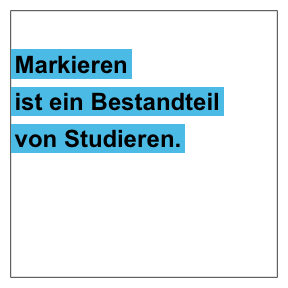
The uline() function allows emphasizing text by plotting
it with colored underlining (to provide the functionality of
“Unterstreichen”):
uline(labels = c("Geradlinig", "Authentisch", "Beweglich", "Offen", "Paradiesisch"),
x = .05, y = .9, y_layout = "even", cex = 1.1, font = 2, new_plot = "slide")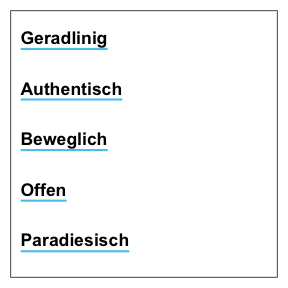
The post() function allows adding text to a rectangular
xbox (to provide the functionality of “Merken”):
xbox(col = usecol(pal_seeblau[[5]]), dim = c(2, 2))
post(labels = c("Für eine", "Kultur der", "Kreativität"), x = .1, y = .8, cex = 1.4, font = 2)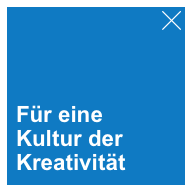
The color and font parameters can be adjusted to obtain different looks:
post(labels = c("creative.", "together"), new_plot = "xbox",
y_layout = .02, cex = 2, font = c(1, 3),
col_bg = pal_seegruen[[1]], col = c(Petrol, Pinky))
The heading() function is a convenient wrapper around
mark:
heading(labels = c("pa-", "ra-", "die-", "sisch"))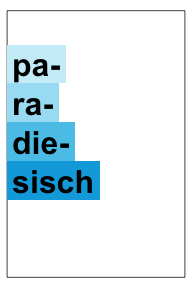
Headings violating the official recommendations (e.g., step-wise titles) will generate a message:
heading(labels = c("Ewig", "währt am", "längsten..."),
y = 2/3, col_bg = usecol(pal_pinky))
#> Step-wise titles are discouraged: Consider re-arranging?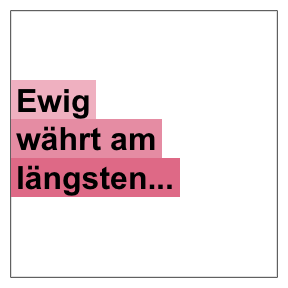
Finally, the url_unikn() function allows formatting URLs
the uni.kn way:
my_url <- url_unikn("https://www.uni-konstanz.de/") # input URL as copied from web browser
post(labels = my_url, x = .2, y = .1, font = 4, new_plot = "xbox")
If custom color palettes are available, the text decoration functions can be used for graphical annotations.
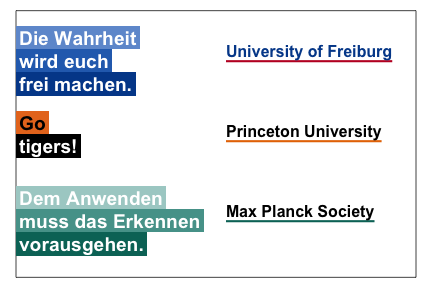
pal_google (defined
above):
Please note the following caveats:
Plotting text (i.e., graphically rendering characters) is rarely a good idea. It typically doesn’t scale (when changing the size of images) and cannot be recognized automatically (e.g., copied, indexed, or scraped). Hence, the corresponding unikn functions should only be used in contexts in which no better solutions are available or practical (e.g., when specifically creating images, or adding annotations to graphs).
Like all templates, our offers are subject to constraints and limitations. As a standard installation of R lacks the “Theinhardt” fonts, we can only mimic the official design specifications (in Arial, sans serif). Nevertheless, the unikn package helps preventing common mistakes by novices (e.g., boxes or lines extending beyond text, or step-functions in multi-line titles) and can be customized and improved by expert users.
Overall, the unikn functions can be useful for solving color-related tasks and plotting graphical elements (e.g., boxes, logos, etc.). Ideally, it should help you in creating a stylish and recognizable design for your presentations and visualizations.

The unikn package is work in progress. We are still working on:
Please contact us in case you need additional features or want to help us implementing them.
The following versions of unikn and corresponding resources are currently available:
| Type: | Version: | URL: |
|---|---|---|
| A. unikn (R package): | Release version | https://CRAN.R-project.org/package=unikn |
| Development version | https://github.com/hneth/unikn/ | |
| B. Online documentation: | Release version | https://hneth.github.io/unikn/ |
| Development version | https://hneth.github.io/unikn/dev/ |
Please report any unikn-related issues at https://github.com/hneth/unikn/issues. We appreciate your feedback, comments, or questions.
The University of Konstanz’s Corporate Design (CD) was created by Strichpunkt GmbH and the University of Konstanz in 2014. The unikn package authors are members of the research group Social Psychology and Decision Sciences (SPDS) at the University of Konstanz. We facilitate access to CD elements for fellow users of R (e.g., for creating scientific visualizations), but all copyrights on the design remain with the original copyright holders.
We aim for an authentic representation of a highly-specified corporate design. While rigid specifications help to maintain coherence and consistency, they also tend to cause frustration in expert users. As the design has been developed in a flexible way that allows for individual elements to be modified as needed, we allow for some liberties, mostly by relaxing some restrictions. Examples include:
seecol() and
usecol() functions to color palettes);Signal color (from
pal_signal);unikn by Hansjörg Neth and Nico Gradwohl is licensed under a Creative Commons Attribution-ShareAlike 4.0 International License. (Based on a work at https://github.com/hneth/unikn).
To support our development, please cite the unikn package when using it in publications or derivations:
The copyrights to all designs remain with their original creators:
Color and text box definitions are based on the following corporate design at uni.kn specifications:
[File README.md updated on 2022-08-15.]
[1] Whereas the official definition does not identify a preferred
color for the Ampel color palette (pal_signal), we provide
its alert color (i.e., pal_signal[2]) as a designated
color Signal.